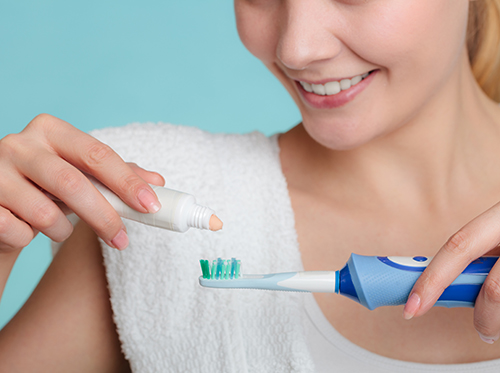Pick the right electric toothbrush!
March 19th, 2019

The electronic toothbrush has undergone several technological advances since the 1960s. Everything from design and bristle motions to rotation, oscillation, and sonic vibration has led to dramatic changes in this necessary tool over time.
Rotation oscillation happens when the head of the toothbrush rotates from one direction to the other. The benefit of powered toothbrushes is that they can produce 50,000 strokes per minute, compared to 300 strokes with a manual toothbrush.
When you’re thinking about brush head size, smaller brush heads are best for hard-to-reach areas and small mouths. Brush heads should be replaced every three to six months as needed. A good way to save money is to designate a brush head for each family member which can be taken on and off a shared base motor.
Having a base motor or rechargeable toothbrush can deliver enough power on a full charge for a week of brushing, which makes it convenient for travel or when life gets busy. Some toothbrushes include audible signals that let you know when to switch the area of your mouth you’re brushing or when a full two minutes has gone by.
Do you have sensitive teeth? Studies have indicated that people tend to apply more pressure on their teeth when they use a manual toothbrush. This makes an electric toothbrush a preferable option if you’re having issues with sensitive teeth or gums.
There are even electric models with pressure sensors that will stop the brush from spinning when you press too hard against your teeth!
Everyone can benefit from having an electric toothbrush. A large handle size can be taken into consideration if a member of the household is young, or has a physical disability or arthritis. They’re even recommended for children in order to maintain good oral hygiene from a young age.
Biofilm is a term used for plaque or debris that builds up in your mouth. If not properly addressed, this can cause serious bacterial infections to your gums and teeth. If you want to remove biofilm in the most efficient way, an automatic toothbrush is the way to go.
When you're ready to make your decision, make sure to consult with Drs. Angela Paros, Amer Atassi, Eric Young, Alexander Katsnelson at our Romeoville, IL office to decide which electric toothbrush is right for you!
Can sealants benefit you?
March 12th, 2019

Molars are difficult to reach when brushing your teeth because they’re full of crevices, caves, and pits that can provide the perfect environment for decay. Sealants are the perfect fix for this.
Sealants are a plastic-like protective solution that bond to the edge of the tooth. The treatment protects you against cavities and could save you from complicated dental issues in the future.
The process for placing sealants is painless and quick. First, Drs. Angela Paros, Amer Atassi, Eric Young, Alexander Katsnelson will clean the tooth with a baking soda spray. An acid etch is applied in order to “roughen up” the surface of the tooth and re-mineralize the area. The area is dried with an alcohol-based liquid and the sealant is placed on the grooves of the tooth. A special light then hardens the liquid into a plastic-like material.
Although sealants can last several years, they need to be examined semi-annually to check for breakage. Any cracks or breaks in your sealant can put your tooth at high risk for decay, and repair of sealants is a quick and painless task.
Children often receive sealants, but people of all ages can benefit from them. Adults who have especially deep canyons on their teeth are good candidates for sealants.
An investment in dental sealants can prevent tooth decay and complicated dental problems later on. It’s a no brainer! Call our Romeoville, IL office today to speak with us about getting sealants on your teeth.
Make Your Smile Dazzling For Your Wedding!
March 5th, 2019

Planning a wedding can be a highly stressful time. Drs. Angela Paros, Amer Atassi, Eric Young, Alexander Katsnelson and our team want to support you in this process by helping you achieve a beautiful, bright smile. Wedding days entail a lot of photographs that will last a lifetime. We know how crucial it can be that you have a smile that makes you feel confident throughout this memorable day.
Whether you’re the bride or groom, a member of the wedding party, or just a guest, a teeth-whitening treatment from Drs. Angela Paros, Amer Atassi, Eric Young, Alexander Katsnelson can give you extra confidence. Even when you’ve made the proper effort to keep up your oral health routine, staining still can appear on your teeth from foods and beverages over time. You can do several things to make sure your smile is in top shape before a wedding.
Our in-office whitening treatment is a good option if you’re looking for an investment that can last. If you’ve tried whitening kits on your own, you may have noticed they have to be used frequently to maintain the bright smile you desire.
Professional whitening treatments done by High Point Dental Group are quite comfortable and have long-lasting effects. You can also use whitening toothpaste and mouthwash to keep your teeth bright between in-office whitening treatments.
Our staff can also provide helpful advice on how to avoid staining between your whitening treatment and the big day. If you’re concerned that you may have to hold back your smile on your wedding day or some other pending event, contact our Romeoville, IL office and ask about our whitening treatment options.
Sleep Apnea: What a Dentist Can Do
February 26th, 2019

You find yourself drowsy and irritable all day. Or you have trouble sleeping, and when you do, you snore loudly throughout the night punctuated with silent pauses where you aren’t breathing at all. Or your loved ones tell you that you’ve been keeping them awake with your snoring or frightening them awake when you gasp for breath. Whatever symptom may have brought you to the doctor, you’ve been diagnosed with obstructive sleep apnea, and now it’s time to get this sleep disorder under control.
Obstructive sleep apnea occurs when the tissue in the back of the throat relaxes, partially blocking the airway, or structural problems in the mouth and throat (such as enlarged tonsils or tongue) obstruct air flow. The tissue around the air passage vibrates with every breath causing those annoying snoring sounds. More dangerous, an obstructed airway means that there is not enough oxygen getting into the lungs. The struggle to breathe wakes us, interrupting the deep sleep we need to function. Untreated, the results of sleep apnea can range from drowsiness and irritability to a greater risk of high blood pressure, heart disease, and stroke. Luckily, there are several approaches to combatting this form of sleep apnea, including life style changes, surgery or breathing machines, and orthodontic appliances.
- Lifestyle Changes
Sleep apnea is more likely to affect those who are overweight, smoke, use alcohol, take certain medications, or sleep on their backs. If you can make changes in your lifestyle that will restore the quality of your sleep, this is a great first option.
- Surgery or Breathing Machines
Sometimes obstruction of the airway is caused by structural problems in the throat or mouth. Tissue can be reshaped or removed during surgery to widen and stabilize the breathing passage. Or you might be prescribed a machine such as a CPAP (continuous positive airway pressure) machine, which blows pressurized air through a tube and mask to keep the airway open during sleep.
- Oral Appliances
Drs. Angela Paros, Amer Atassi, Eric Young, Alexander Katsnelson can also be an important resource if you struggle with obstructive sleep apnea. Many people suffering from this disorder prefer an oral appliance for its effectiveness, comfort, and convenience. One common oral sleep appliance is designed to support your lower jaw in a forward position. This jaw movement increases the open space of your airway as you sleep. Other appliances can prevent the tongue from blocking the airway and obstructing air flow. These appliances resemble mouthguards and retainers, and, like them, are custom made just for you. We will recommend the type of appliance best suited to your needs, and will take a model of your mouth and teeth so that a lab can craft an appliance that will be a perfect fit. We will adjust it for comfort if necessary, instruct you on its use and care, and schedule follow up treatment to make sure the appliance is treating your sleep apnea as efficiently as possible.
Whether you opt for a change of lifestyle habits, a CPAP machine, surgery, or an oral appliance, it is important that you treat this sleeping disorder. Left untreated, obstructive sleep apnea can have many serious consequences. If you suspect you might have sleep apnea, talk to us during your next visit at our Romeoville, IL office. You deserve a good—and healthy—night’s sleep.






